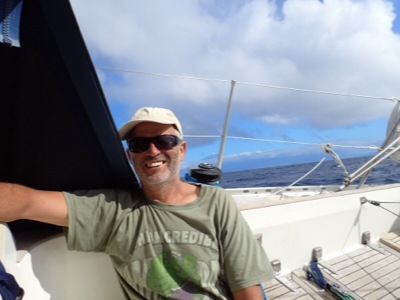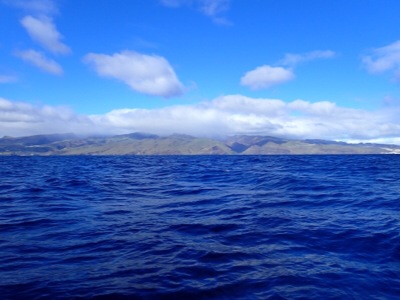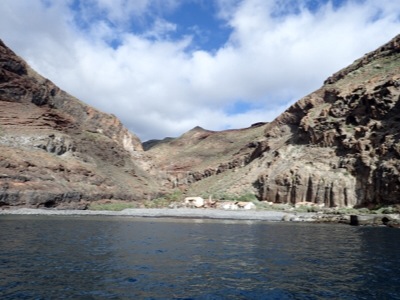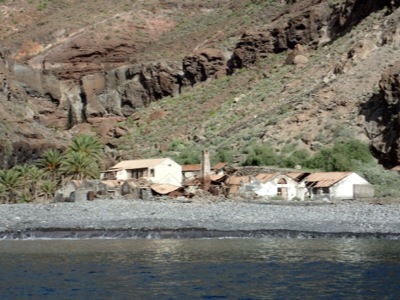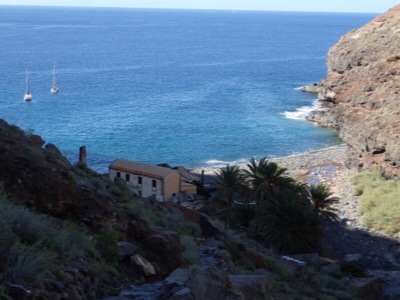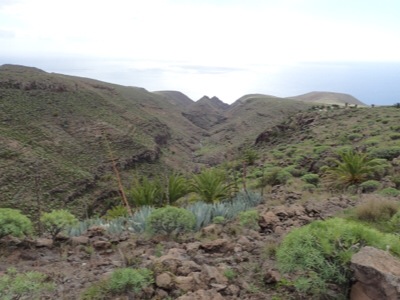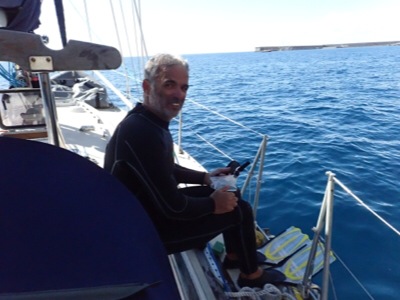La Gomera

Caramor - sailing around the world
Franco Ferrero / Kath Mcnulty
Tue 9 Dec 2014 21:48
Tuesday 2nd December 2014
Despite all the weather forecasts agreeing on a north easterly, the wind itself remained stubbornly from the south west.
The sail from Gran Canaria to La Gomera would take more than a daylight day, hence we had decided to leave in the evening, sail overnight and arrive sometime during daylight the following day. We motored out of Pasito Blanco and up the coast as the wind was very light but soon it turned to the expected direction and increased to 18 knots.
Sailing in the Canary archipelago has its challenges, the forecast may be for Force 4-5 and yet you could be sailing in Force 7. This is because when the wind hits an island with tall mountains, it is forced to divert round the sides creating wind acceleration zones while just a few metres away in the lee (immediately downwind) of the island it is flat calm.
18 knots is when we nominally take in the first reef (reducing the size of the sail), to reef or not to reef is the eternal question. Franco, usually a reluctant reefer was this time adamant that we should. By the time we had finished taking in the first reef the wind was up to 24 knots, a breezy night. It remained between 22 and 29 knots until we arrived near the southern tip of Tenerife.
At the 2am shift change, I came up and noticed a very bright red light near the shore and wondered if it was something to do with the nearby airport. As Franco went below he glanced at the AIS (the instrument which gives other boats our position and us theirs) and said "there's a boat really close by". I scanned the dark sea in front and towards the brightly lit coast of Tenerife; nothing, I looked backwards towards the bright red light and above it I could just make out the white ghost of sails, it was a sailing boat heading in the same direction as us.
An instant later, the VHF crackled "Caramor, this is Beagle VI, you will pass behind us won't you". How cheeky! In the rules of the sea 'overtaking boat gives way', he was faster and since we were both heading more or less downwind, he should simply steer a course to avoid us. Franco very obligingly made us change course and let him pass.
When I got up at 8am to make breakfast, Franco was sat in the cockpit with his arms folded looking glum. The wind had died down and changed direction many times, after Caramor had gone round in circles twice, Franco had given up on steering.
We spotted a pod of sperm whales (of Moby Dick fame) not far from the boat and heading in the same direction, it was our first sperm whale sighting and we identified them by their distinctive large square heads.
Franco with El Teide volcano on Tenerife behind
After breakfast, as there was still no wind we started the engine, five minutes of motoring and we hit a wind acceleration zone, it went from 5 knots to 19 knots in a second and we were off like a shot.
La Gomera
Early afternoon we arrived at the first possible anchorage, Playa de la Cantera, the site of a derelict tuna fish canning factory and dropped the pick.
Playa de la Cantera
The tuna canning factory
We tidied up on board and noticed that the rope which control Aries our windvane self-steering had been caught under a sharp edge and had rubbed itself to tatters, we hadn't noticed in the dark, also the batten in our sail cover had at some point in the night jumped overboard. Franco spliced a new line for Aries and I made little pockets to keep the battens in. Hopefully we will be able to order a new one in La Palma. There is always maintenance to do on a sailing boat.
The next morning we rowed ashore as we had spotted a path up the cliff, as we passed the factory it became apparent that it wasn't as abandoned as it looked when we were met by a charming young woman watering cacti. She and four friends are renting the ruins and the land and live here on and off, they have planted over 60 fruit trees which need watering every other day. They are doing the buildings up gradually, a Herculean job as the nearest road is over an hour's walk away! Our friend turned out to be French, she speaks perfect Spanish and very good English. She gave us a bag of delicious dates from her trees.
The walk was steep and took us to the small German village of Alejero where we had our lunch before heading back downhill.
Looking back towards Caramor and her new friend 'Manzanilla' in the bay
The barranco
The following morning, once the sun got above the cliffs we went snorkelling, not much to see, a few Dorado fish and Caramor's dirty bottom - we must do something about it.
We set sail after lunch for another anchorage five nautical miles up the coast, at Vueltas at the mouth of Valle Gran Rey (the valley of the great king) where the cliffs are 500m high.
The 500m high cliffs at Vueltas
Saturday we headed into town to check our email. Vueltas is a very German resort complete with Konditorei (posh bakery) and Metzgerei (charcuterie shop). We had been hoping to catch a bus the next day to go for a walk in the National Park at the centre of the island, unfortunately buses on Sunday are few and far between and we could only find the departure time, not the return. I rang the 'for more information number' which had a recorded message which said "for information about the timetable, please refer to the internet page". Fantastic! A great virtuous circle.
Instead of going for a walk, we donned our wet suits and cleaned Caramor's hull. It was mostly weed though there were a few barnacles and patches of calcareous growth. The water was warm but after several hours we felt quite chilled.
Franco preparing to dive
Dynamic bottom cleaning
Kath
